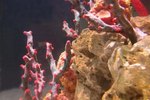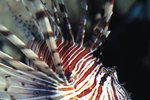
Many properties of water, completely invisible to the naked eye, can mean life and death to aquarium fish. One such parameter, pH is a measurement of the hydronium concentration of a water sample plotted on a negative-logarithmic scale. This is fancy talk talk for how acidic or basic water is. Most fish have a specific ideal pH range they need to thrive, and you must provide this in your aquarium for your fish to survive.
Identify Issues
First, you need to figure out why the pH has dropped. Test the pH of your tap water to see if the issue is there. The pH of tap water varies throughout the country, and the local water source may have a naturally low pH. If the tap water's pH is appreciably higher than the aquarium's, you should test for ammonia, nitrite and nitrate. These compounds can lower the pH -- and they are dangerous all by themselves. Additionally, some aquarium decorations like driftwood can lower pH.
Passive Methods
Certain aquarium decorations can raise pH. In fact, saltwater aquarium hobbyists often rely on this. Many of the same products can work in a freshwater tank if you desire a high pH. Crushed coral sand or calcium-rich rocks like limestone or tufa can slowly leach calcium into the water, raising the pH, alkalinity and calcium levels of aquarium water. This mimics the hard, alkaline water where some species of aquarium fish originate.
Active Methods
Pet shops also sell chemicals specifically designed to raise the pH of aquarium water. These may come in a liquid or a solid form. Many pet shops sell cichlid salts, calcium salts that can dissolve and raise the pH and alkalinity of aquarium water. While these products are designed for African cichlids, fish from other regions where the water has a higher pH, like Central America, can benefit from these products as well.
A Word of Caution
Keep in mind that fish react poorly to sudden changes in pH -- even changes towards ideal conditions. Never change the pH by more than .2 per day -- pH does not have units. Additionally, pay attention when you perform water changes if you have raised the pH of the aquarium's water. Make sure you adjust the pH of your tap water to your aquarium, in addition to dechlorinating it.
References
Photo Credits
-
Jupiterimages/Photos.com/Getty Images




